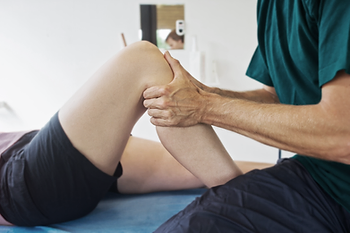

The knee is one of my favorite joints to treat as a PT. I personally have had on/off knee pain for years as a result of a lot of hours playing basketball and running a marathon without training. You heard that right. Yes this was long before I was an educated and trained PT 😉 Dealing with that myself has given me a unique interest in this oftentimes troublesome joint. The knee joint is commonly referred to as the “victim joint”, as it is stuck between the ankle and the hip, and your level of mobility or strength at those 2 joints is often what may be contributing or causing your knee pain. Here is my list of 4 common causes of knee pain that I have seen in my clinical practice.
1. Hip weakness, specifically in gluteus medius and the group of muscles responsible for hip external rotation and pelvic positional stability. The reason for this is that weakness in these muscles can cause the pelvis to drop on one side and the hip to internally rotate during functional or sport movement such as running, squatting, jumping etc. Clinically this condition is referred to as knee valgus, and it refers more to this happening in a dynamic aspect (during a challenging physical activity) vs. static (standing still). Knee valgus is a common cause of runner’s knee (chondromalacia) due to the alignment of the knee causing irritation under your knee cap as your knee bends and straightens during activity. Knee valgus is also a known risk factor for ACL injury.
SOLUTION: Strengthen hip external rotators and hip abductors.
Beginner: Sidelying clams, sidelying leg raises
Intermediate: Band resisted sidestepping and squatting
Advanced: Box Jumps with focus on knee alignment over toes
Video demonstration to come

2. Weak posterior chain and over dominant quadriceps. The key here is essentially an balance between your front and back leg muscles, with the front muscles most often being the primary culprit for over dominating. Posterior chain refers to the group of muscle along your posterior which primarily includes your glutes, hamstrings, and lumbar extensor musculature. An underactive posterior chain and overactive quadriceps can lead to increased stress across the patellar tendon, commonly resulting in patellar tendonitis (acute) or tendinopathy (chronic).
SOLUTION: Facilitating the posterior chain with motor retraining exercises. This one often is more of an issue of poor motor control than just pure strength, although strength can also be an issue. Either way, doing exercises to focus on 1. recruiting the hamstrings and glutes (Romanian dead lifts, supine leg curls on ball, roman chair lowers) and 2. Inhibiting the quadriceps and hip flexors (quad and hip flexor stretching) is often the solution.
Video demonstration to come
3. Weak ankles or collapsing arch. Looking at your knee from the ground up, if you have a low or no arch, have poor support in your shoes, or just have weak ankles, what you will often see is the collapsed ankle causing your knee to collapse in as well, referred to above as knee valgus.
SOLUTION: Sometimes it can be just wearing the right shoes with more arch support, especially if the start of pain was shortly after wearing a different pair of shoes during an activity. In the way of exercise it is about strengthening the muscles that support your arch by performing resisted ankle inversion and supination (with a band anchored somewhere, place your foot in the band and turn your foot inwards), but then progressing to practicing arch stability standing on uneven surfaces.
Video demonstration to come
4. Overuse. This one is simple. You have overdone it, with too much load, too fast and possibly without enough rest. While obviously it is often our goal to apply stress or load to muscle groups as this is the only way to improve strength, if you bump it up too fast, your tissues don’t have time to adequately repair, which creates an inflammatory response and possibly pain. If the stress/load is very significant, you can overload it all at once to the point of mechanical failure and cause a tear or other acute injury to the muscle or connective tissues such as ligaments or joint capsules.
SOLUTION: Graded stress is the name of the game. This takes patience and not trying to push too much at once which can be hard to judge. But that is where the skills and clinical eye of a Physical Therapist comes in to appropriately progress your exercise and load tolerance. Body mechanics are also very important to ensure that loads are not only being applied in the right dosage, but also in the right way, and the safe way. Again this is best taught under the skilled guidance of a PT.

